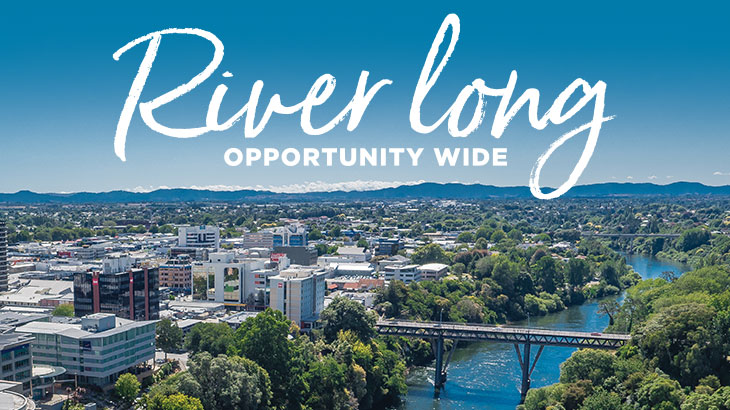River long, opportunity wide
River long, opportunity wide
Total Property - Issue 4 2020
As the country emerges from a pandemic blur and businesses get on with life after a significant hiccup, the good news keeps rolling in for New Zealand’s fourth largest city, Hamilton.
It was recently announced that the New Zealand Institute of Skills and Technology will be headquartered in Hamilton after a successful joint bid by Hamilton City Council, Te Waka (Waikato's Regional Economic Development Agency), Waikato-Tainui and the Waikato Chamber of Commerce.
“The mega-organisation will see the country’s 16 institutes of technology and polytechnics – along with all industry training organisations – merge into one national entity and it’ll be based in Hamilton,” says Bayleys Waikato commercial manager, David Cashmore.
“This show of confidence is reflective of the city’s education sector strength, its central location and its ‘can-do’ attitude – it’s a great endorsement for Hamilton.”
Cashmore says there’s a vibe in the Hamilton commercial and industrial market at the moment that even COVID-19 couldn’t touch.
“I think there’s an acknowledgment and relief that Hamilton is well-insulated from the more widespread fallout being seen around the country from the lack of international visitors and the associated tourism sector woes,” he says.
“The region thrives on the back of key sectors other than tourism and from what we’re seeing on the ground currently, Hamilton is very much open for business.”
When Cashmore summarises the pipeline of construction and infrastructural work underway or in the planning stages for Hamilton, you’d be forgiven for thinking this was an Auckland roll call of development projects.
“It’s actually quite staggering and we’re talking weighty stuff here from majorly-enabling roading projects to a performing arts venue, multiple high-profile mixed-use developments, new hotels, freight hubs and educational headquarters.
“Add in the inland port developments at Horotiu north of Hamilton and the emerging Ruakura Inland Port and the region’s place in the country’s logistics and supply chain equation is further cemented.”
Calling it “the logical alternative to Auckland”, and applauding the fact that there’s a four-lane highway all the way between Hamilton and Auckland now, Cashmore says the drift of big business to Hamilton on the back of roading initiatives is making a huge difference to the economic profile of the city.
“With Auckland only one hour 10 minutes away by car and with a Hamilton-Auckland commuter train service tipped to start at the end of this year – why wouldn’t you consider Hamilton as a place to anchor your business from?
“Thanks to the likes of Rabobank and AA Insurance consolidating their business operations in Hamilton, there’s demonstrated credibility of the city’s economic fundamentals.
“The relative geographical stability of the Waikato region also gives confidence to businesses such as data centres because the threat of disruption due to earthquake or other natural activity is minimised.”
In marketing for lease the retail and hospitality components of the high-profile new Union Square mixed-use development, being spearheaded by local development and construction company Foster Group, Cashmore signals more opportunities in the wind.
“The post-COVID environment will emphasise the importance of supporting local and provide the chance for astute operators to push the reset button and be part of a reimagined, vibrant city centre,” he says.
The recently-confirmed Waikato Regional Theatre project will also add to the creative lifeblood of the city according to Cashmore, with plans for a world-class community facility set to provide some cultural impetus for Hamilton.
“It’s all a good shot in the arm for the city’s commercial centre.”
An ambitious city
Jen Baird, Hamilton City Council’s general manager city growth, says recent feedback from the business community overlaid with local and national data suggests Hamilton’s economy will recover more quickly than the rest of the country in the wake of COVID-19.
“The fundamentals that make Hamilton a good place to invest and grow remain largely unchanged,” she explains.
Baird says Hamilton is an ambitious, smart and progressive city which enables and encourages innovation, knowledge and sustainable growth.
“Its population is growing faster than the national average, it’s the youngest territorial authority with an average age of 32, has a highly-educated, tech-savvy workforce and has been New Zealand’s fastest-growing tech sector for the last two years.
“Further, it has relative affordability in terms of home ownership and as a place to do business.”
Plans to create a more river-facing vibrant city centre mirrors moves of other cities around the world to maximise the value of natural assets to encourage business growth.
“This is our waterfront and we must create opportunity for people to see it, get alongside it, and overlook it,” she says.
Ensuring resilient local and regional transport links, protecting high-value land while enabling development in the right areas, and optimising services like water and wastewater from a regional perspective are all-important.
“We’re doing this through key initiatives like the Future Proof partnership, Hamilton to Auckland Corridor Plan and Hamilton-Waikato Metropolitan Spatial Plan development,” explains Baird.
“The Hamilton to Auckland Corridor project maximises the considerable infrastructure investment between the two cities and leverages off improvements to State Highway 1 and ongoing investment in the Waikato Expressway, main trunk rail and inland ports.
“This strong economic corridor is playing a big role in supporting jobs in Hamilton and the wider region and contributing to our position as a leading commercial centre.”
Read more market insights from Total Property
Subscribe to receive the latest commercial news and insights from Bayleys Total Property
